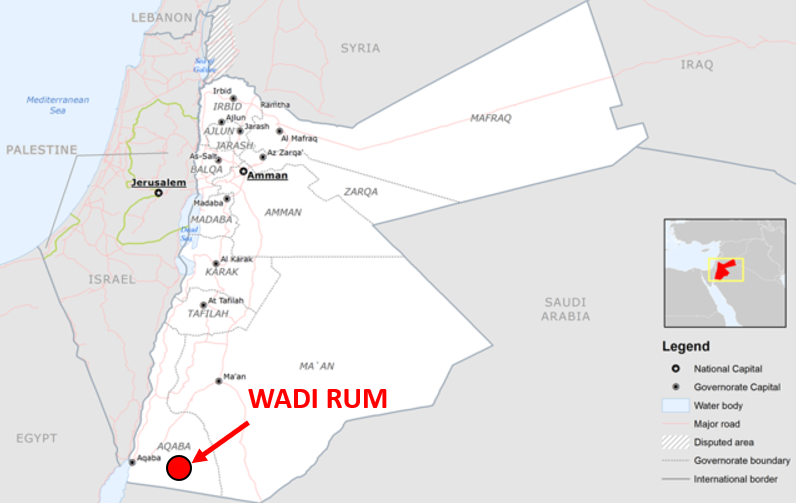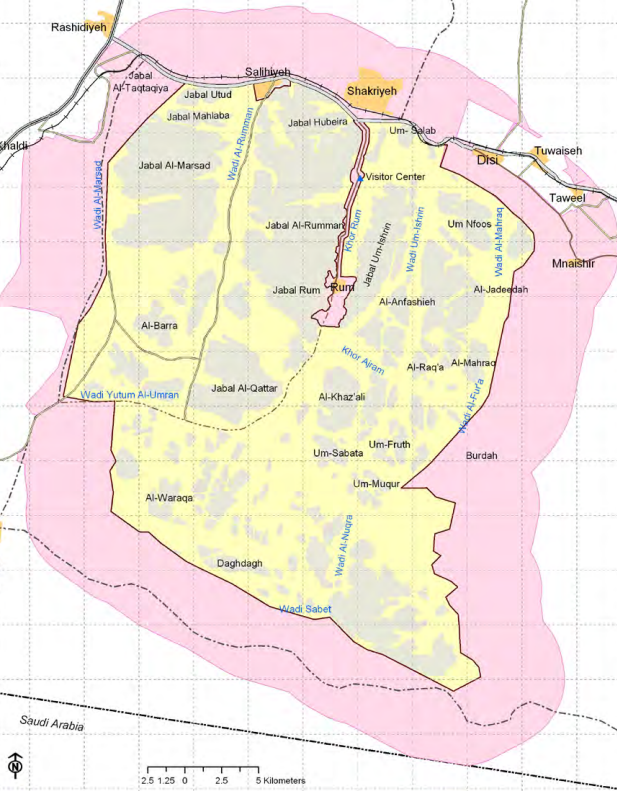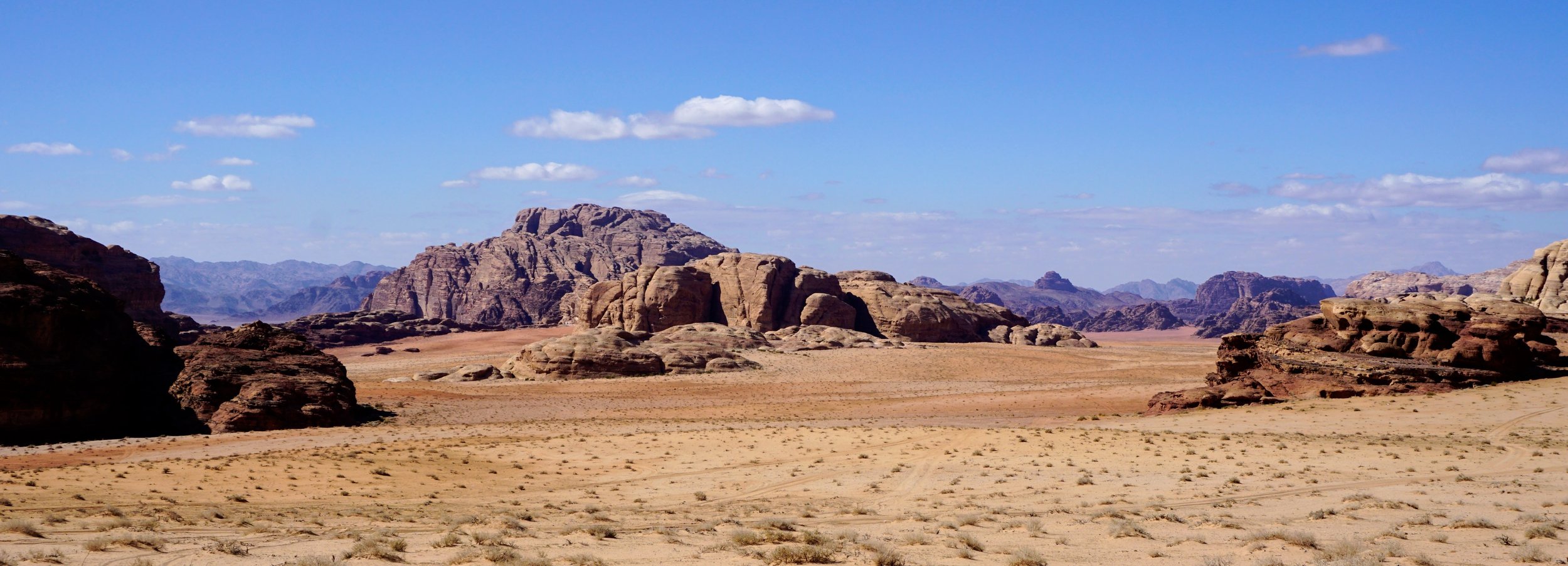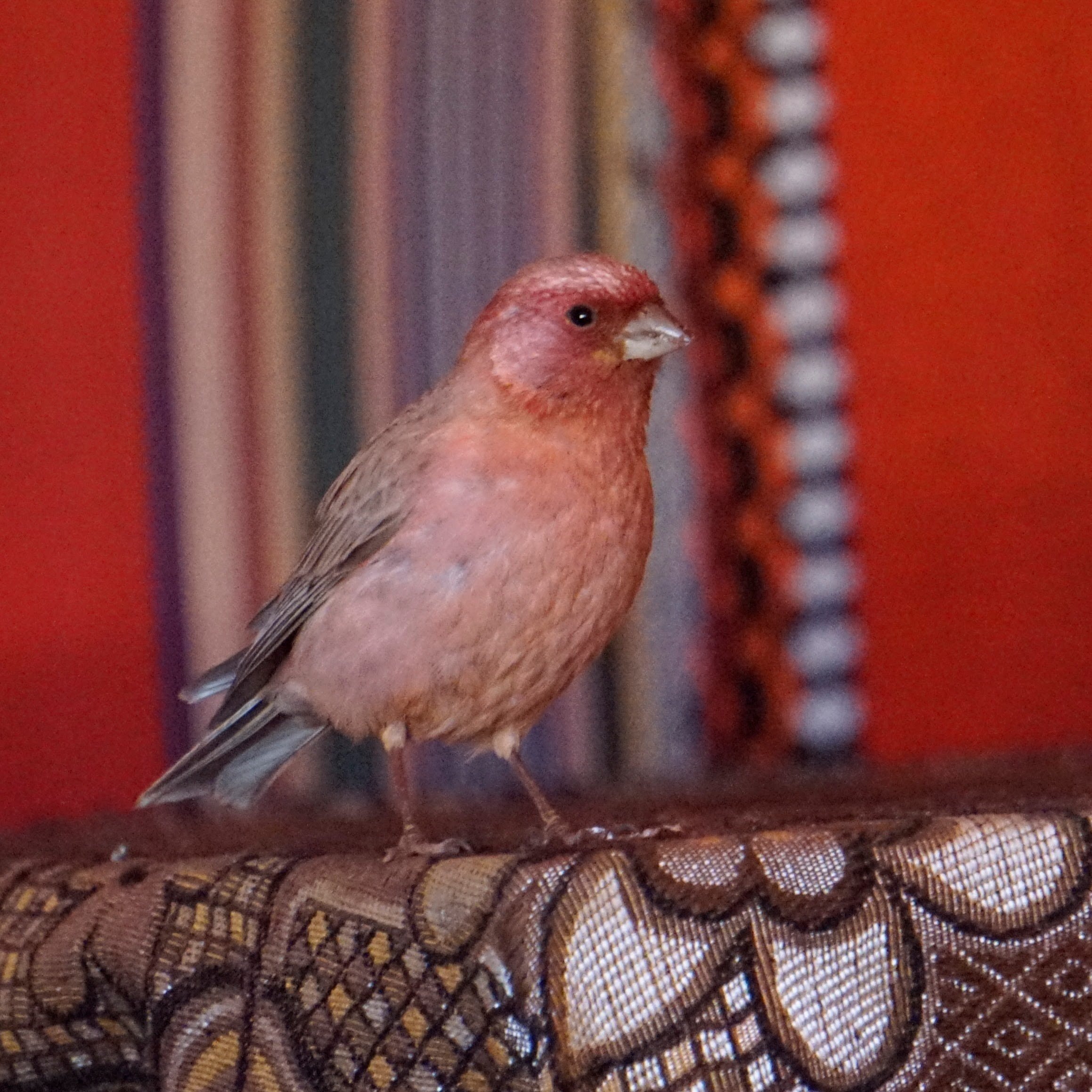Wadi Rum
A Complete Guide to the Wadi Rum desert in the south of Jordan
Wadi Rum is an absolute must-visit location on any trip to Jordan. On this page, we’ve provided a lot of useful and interesting information about the Wadi Rum desert, its people, its history and culture, the links between Wadi Rum and Hollywood, and more. We’ve also included many links to other websites if you are looking to learn more. If you have any questions, feel free to send us a message. We are proud of our lands and culture and happy to share with our guests.
Our guides to Wadi Rum are also available in:
Wadi Rum - Location
Where is Wadi Rum?
Wadi Rum is in the south of the Hashemite Kingdom of Jordan. Wadi Rum is the name given to the area in which the biggest and most important wadi is called Wadi Rum. Wadi, in Arabic, means river valley. However, you will not see many rivers flowing on your visit to the desert. Although Wadi Rum is the biggest and most important wadi in the area, it is not the only one. For example, Wadi Sabet is another large wadi located within the Wadi Rum area, located in the southern half of the Wadi Rum Protected Area.
Wadi Rum is located approximately 60 km to the east of the important port city of Aqaba. It takes approximately one hour to reach the Wadi Rum village from Aqaba by car. Further, it is located approximately 100 km south of Wadi Musa, the town located next to Petra. Also, Wadi Rum is located around 300 km south of Jordan’s capital city Amman, a journey that takes around four hours by car. To access Wadi Rum from any of Jordan’s main cities or tourist attractions, it is necessary to take the Desert Highway (Highway 15). This highway connects the country from north to south and is much faster, but much less interesting compared to Highway 65 which also connects the country from north to south but using a much smaller and less direct route along the Dead Sea.
Where is the Wadi Rum Protected Area?
The Wadi Rum Protected Area was established by the Jordanian government in 1997 and has been a UNESCO World Heritage site since 2011. The Protected Area covers an area of about 74 000 hectares. It was established to protect both its natural and cultural history. The Protected Area is famous for its magnificent desert landscapes, varied geology, inscriptions and archaeological remains, hiking and climbing, being used as a Hollywood film set, and of course the Bedouin hospitality.
The boundaries of the Wadi Rum extend from the Wadi Rum Road in the north to near to the border with Saudi Arabia in the south. There is only one village inside the Wadi Rum Protected Area, the Rum Village. Just outside of the protected area you can find the villages of Rashidiyeh, Salihiyeh, Shakriyeh, Disi, Tuwaiseh, Taweel, and Mnaishir. Not far from the Wadi Rum Protected Area Mohammed bin Zayed Al Nahyan, the crown prince of Abu Dhabi, has constructed a controversial artificial oasis used as a private hunting reserve.
Where is the Wadi Rum Village?
The Rum Village is located inside the Wadi Rum Protected Area, about 5 km south of the northernmost extreme of the Protected Area and the village of Shakriyeh. The village was established in the wadi between Jebel Rum and Jebel Umm Ishrin, the second and third tallest mountains in Jordan, respectively. Wadi Rum has plenty of cultural history, but the village itself is not historically significant. The village was only established around 1980. Prior to this, the people of Wadi Rum lived a nomadic lifestyle in the desert. Many of the older people you will meet in Wadi Rum were born in the desert and have spent significant periods living as nomads as their families have for centuries. These days, the Rum Village has a population of around 2000 people and is growing rapidly.
The Wadi Rum Village, viewed from Rakhabat Canyon. Photo taken in 2019 by Matthew Cruickshank.
As the Rum Village is located inside of the Protected Area, it is subject to certain restrictions. For example, buildings are not allowed to have more than one story. All the houses in the Rum Village do not have a second floor. Tourist accommodation is not permitted in the village. If you have a room booked in the Rum Village, in most cases you will be transported to a desert camp upon arrival. All the camps in the Wadi Rum Protected Area are in off-road areas outside of the village.
The Wadi Rum Village, viewed from the south. Photo taken in 2023 by Matthew Cruickshank.
When you are planning your trip to Jordan, be sure to check if your camp is in the Protected Area. Some popular camps are located outside of the Protected Area next to Disi Village. If you reserve a tour with these camps, they may not even bring you inside the Protected Area, instead bringing you north and pretending that it is inside Wadi Rum! Our camp is in the heart of the Wadi Rum Protected Area, built on the eastern side of Jebel Khazali. Click here to learn more about our desert camp.
““You’ve got to do Wadi Rum,” he said. “That’s my favorite. It’s just a magical place, outstanding, especially for an overnight. A week before graduation, I would spend the night there with the senior class of the King’s Academy, a private boarding school, and I used to have birthday parties for my eldest son [Crown Prince Hussein] there. We would camp out, and now it has become a favorite place of his, too.””
Wadi Rum - Geography and Geology
Wadi Rum is a geological and geographical marvel located in the southern part of Jordan. Its landscape is a testament to the powerful forces of nature that have shaped the region over millions of years, resulting in a unique and awe-inspiring desert environment.
A desert landscape in the Wadi Rum desert. Photo taken in 2023 by Matthew Cruickshank.
Geological Features of Wadi Rum
1. Sandstone Mountains and Rock Formations: One of the most striking features of Wadi Rum is its towering sandstone mountains and rock formations. These monoliths, some rising over 1,700 meters in height, have been carved by the erosive forces of wind and water. The sandstone layers reveal a history of sediment deposition in ancient seas, uplift, and tilting due to tectonic activity. This layer-cake appearance of the cliffs and mountains offers a glimpse into the geological history of the region.
2. Erosional Landscapes: Wadi Rum's landscape is a product of ongoing erosion. Wind and occasional flash floods have shaped the terrain, creating a labyrinth of canyons, arches, bridges, and narrow gorges. These erosional features provide not only breathtaking vistas but also insights into the dynamic processes that continue to shape the desert.
3. Arid Climate and Dunes: The desert climate of Wadi Rum is a significant factor in its geography and geology. The arid conditions, with limited vegetation and sparse rainfall, have contributed to the formation of extensive sand dunes. The dunes are shaped by prevailing winds that transport sand particles and deposit them in mesmerizing patterns across the desert floor.
4. Geological Diversity: Wadi Rum's geology boasts a rich diversity of rock types, including sandstones, conglomerates, and limestone. These rocks tell a story of ancient environments, from seabeds to desert landscapes, that have evolved over geological epochs. Petroglyphs and inscriptions etched into the rocks by past civilizations provide cultural and historical insights alongside the geological narrative.
Geographical Features of Wadi Rum
1. Valleys and Wadis: Wadi Rum is crisscrossed by wadis, which are dry riverbeds that wind through the landscape. These valleys provide natural pathways for exploration and are evidence of the region's occasional flash floods. The intricate network of wadis adds to the geographical allure of Wadi Rum, inviting adventurers to discover hidden corners of the desert.
2. Sand Dunes: The vast sand dunes of Wadi Rum contribute to its unique geography. The undulating dunes create a sense of endless space and tranquillity, adding to the surreal and otherworldly atmosphere of the desert. These dunes are constantly shifting, reshaped by the wind, and offer opportunities for activities like sandboarding and camel trekking.
3. Mountain Peaks and Plateaus: Jebel Um Ishrin and Jebel Rum are some of the most prominent peaks in Wadi Rum. These mountains and plateaus provide elevated viewpoints from which visitors can marvel at the expansive desert vista. They are not only geological landmarks but also integral to the geography, shaping the horizon and adding depth to the landscape.
4. Breathtaking Sunsets: The geographical layout of Wadi Rum, with its vast open spaces and towering rock formations, makes it a prime location for capturing breathtaking sunsets. As the sun dips below the horizon, the desert transforms into a canvas of warm hues and deep shadows, creating a magical and serene ambiance. For all of our Wadi Rum desert tours, we take our guests to a fantastic spot to view the sunset.
The geographical and geological features of Wadi Rum, Jordan, come together to create a mesmerizing landscape that embodies the Earth's dynamic processes and the passage of time. The interplay between sandstone mountains, erosional landscapes, arid conditions, and unique rock formations makes Wadi Rum a true wonder of nature, inviting exploration, admiration, and contemplation.
Sunset in the Wadi Rum desert. Photo taken in 2019 by Matthew Cruickshank.
The Bedouins of Wadi Rum
The Bedouins of Wadi Rum, Jordan, are an integral part of the region's cultural tapestry, with a history deeply intertwined with the desert landscape. For centuries, these nomadic herders and traders have called Wadi Rum their home, adapting to the challenges of the arid environment while preserving their rich traditions and way of life.
Radi Oudeh, the manager of Wadi Rum Nature Tours is a Bedouin who was born and raised in Wadi Rum.
The history of Bedouin presence in Wadi Rum dates back centuries. Traditionally, the Bedouins were skilled desert dwellers, mastering survival in the harsh conditions through their deep understanding of the land, its resources, and its rhythms. They traversed the desert, moving with their herds of goats, sheep, and camels, seeking pastures and water sources in a semi-nomadic lifestyle.
In the present day, while most of the local Bedouins have transitioned to more settled lives in the Rum village, many continue to maintain connections to their ancestral lands beyond the village. The people living in the Rum Village today belong to the Zalabieh tribe, who settled the village in around 1980. Many have embraced tourism as a means of livelihood, offering visitors an authentic insight into their culture and heritage.
The Bedouins of Wadi Rum bring their sheep, goats, and camels deep into the desert after a rainfall when the grass is plentiful.
Despite embracing modern lifestyles to some extent, the local people still hold onto their cultural identity. Many still reside in traditional goat-hair tents on the outskirts of the village, which are symbolic of their nomadic heritage. The sense of hospitality and community remains a hallmark of Bedouin life, as they welcome travelers with open hearts and share meals and stories around campfires. For the Bedouins who have a home in the Rum village, many will spend months or weeks living in tents in the desert after rainfall when the grass is plentiful and their goats, sheep, and camels can eat well.
Economically, many Bedouins now engage in various activities beyond herding, such as handicrafts and providing accommodations to tourists in desert camps. Some have found success in showcasing their weaving skills, producing intricate textiles and carpets. These crafts not only provide a source of income but also serve as a means of preserving and passing down cultural knowledge to younger generations.
However, the Bedouin way of life in Wadi Rum faces challenges, including the pressures of modernization, changing land use patterns, and the potential impact of tourism on their cultural practices. Balancing tradition with the demands of the modern world presents a complex dynamic for the Bedouins as they navigate their future.
“When a baby is born, the father hunts for a scorpion, then burns and crushes it, mixes it with olive oil, and applies it to the child’s body out of the belief that the treatment would protect the infant from scorpions during his life.”
The Bedouins of Wadi Rum enjoy sharing their culture and history with guests. When you come to Wadi Rum for a tour, do not be afraid to ask questions about their culture, cuisine, history, or anything else that piques your interest.
Interested in learning more about Bedouin culture in Jordan? Check out the links below to learn more:
Photo story: The Nomadic Bedouins of Jordan (National Geographic, 25 July 2019)
Untold bedouin traditions still alive in Wadi Rum (The Jordan Times, 2 October 2017)
Zarb: The Bedouin answer to barbecue (BBC Travel, 4 September 2018)
The secret ingredient to a lavish Bedouin feast (Los Angeles Times, 27 February 2021)
The Nabataeans and Wadi Rum
The Nabataean people and Wadi Rum share a historical and cultural connection rooted in the ancient past. The Nabataeans were an ancient Arab civilization that flourished in the region from around the 4th century BCE to the 2nd century CE. Wadi Rum, located in present-day Jordan, was part of the Nabataean Kingdom and held significance in their trade and cultural activities.
Ancient inscriptions found in Wadi Rum.
Historical Connection: The Nabataeans established a sophisticated network of trade routes that connected their capital city, Petra, to various trade centers across the Arabian Peninsula, the Levant, and beyond. Wadi Rum, strategically positioned along these trade routes, played a crucial role as a resting place for caravans, providing water, shelter, and safety for traders and their animals.
Cultural Influence: The Nabataeans left their mark on Wadi Rum through inscriptions, petroglyphs, and archaeological remains. The desert cliffs and rocks of Wadi Rum bear witness to their presence, as they carved inscriptions in various languages, including ancient Arabic and Greek. These inscriptions offer insights into their culture, activities, and connections to the broader trading world.
Trade and Commerce: Wadi Rum's location between the Red Sea and the Dead Sea made it an ideal hub for the Nabataeans' trade operations. They controlled the incense trade routes, which brought precious commodities from southern Arabia to the Mediterranean markets. The Nabataeans established water cisterns, wells, and other infrastructure in Wadi Rum to support their trade caravans and sustain the nomadic lifestyle of the region.
The remains of a Nabataean temple, on the outskirts of the Wadi Rum Village.
Rock Art and Carvings: The Nabataeans' presence in Wadi Rum is also evident in the rock art and carvings found throughout the landscape. These artworks depict various aspects of their daily life, including hunting scenes, animals, and symbols. Some inscriptions also contain information about their leaders and caravans passing through the area.
While the primary Nabataean urban center was Petra, Wadi Rum served as an essential outpost along their trade routes and played a role in supporting their economic and cultural activities. The Nabataeans' legacy in Wadi Rum offers a glimpse into the complex society and dynamic trading network that characterized this ancient civilization. Today, the Nabataean influence on Wadi Rum's history and landscape adds to the mystique and cultural richness of the region, making it a captivating destination for history enthusiasts and travellers alike.
To learn more about rock art and inscriptions in Wadi Rum, we recommend the following links:
To learn more about the Nabataean people and civilization, check out the following articles:
Lawrence of Arabia and Wadi Rum
What is the link between Lawrence of Arabia and Wadi Rum?
The link between Lawrence of Arabia and Wadi Rum is both historical and cinematic, intertwining real-life events with the magic of filmmaking. The movie, directed by David Lean and released in 1962, not only captured the essence of T.E. Lawrence's wartime experiences but also showcased the captivating landscapes of Wadi Rum, which stood in for various locations in the Arabian Peninsula.
T.E. Lawrence, a British archaeologist, military officer, and diplomat, played a significant role during World War I in the Arab Revolt against the Ottoman Empire. Wadi Rum, with its vast desert expanses and intricate rock formations, was a place of strategic importance in Lawrence's campaign. The real-life Lawrence spent considerable time in the region, using its rugged terrain as a base of operations and rallying the Arab tribes for the revolt.
When it came time to make the movie adaptation of Lawrence's life, Wadi Rum was a natural choice for capturing the essence of the Arabian desert. The vast, open spaces and dramatic landscapes of Wadi Rum were a perfect stand-in for the deserts of Arabia. The filmmakers skillfully utilized the desert's sweeping sand dunes, towering rock formations, and expansive vistas to recreate the environment that shaped Lawrence's experiences.
Seven Pillars of Wisdom in Wadi Rum, named after T.E. Lawrence’s autobiography.
Wadi Rum's role in the film was pivotal in bringing both the historical narrative and the cinematic vision to life. The desert landscapes not only provided an authentic backdrop for Lawrence's adventures but also became an integral character in the story, reflecting the challenges and allure of the Arabian desert. Click here to watch a quick scene from Lawrence of Arabia with a famous Wadi Rum landscape acting as a stunning desert backdrop.
Lawrence of Arabia garnered critical acclaim and is considered a masterpiece in filmmaking. The movie's success is in part attributed to the captivating portrayal of Wadi Rum's landscapes, which added depth and authenticity to the narrative. The link between the historical events of T.E. Lawrence's life and the cinematic depiction in Wadi Rum demonstrates the power of landscapes to shape both history and storytelling. The desert's enduring appeal continues to capture the imagination of audiences, connecting them to the past and the magic of the silver screen.
When you visit Wadi Rum, your guide will take you to see Lawrence Spring and Lawrence’s House. These are both named after T.E. Lawrence, but whether these places actually had any significance for him is now known. Also, when you arrive at the Wadi Rum Visitor Center, if you look to the east you can see an interesting geological feature called the Seven Pillars of Wisdom, named after T.E. Lawrence’s famous autobiography.
If you’d like to read more about T.E Lawrence, we recommend the following articles:
Wadi Rum and Hollywood
In addition to Lawrence of Arabia, several other films have been shot in the breathtaking landscapes of Wadi Rum. Some notable examples include:
Star Wars: The Rise of Skywalker being filmed in Wadi Rum in 2018.
Red Planet (2000): This science fiction film, directed by Antony Hoffman, used Wadi Rum to depict the surface of Mars. The unique desert terrain of Wadi Rum provided a convincing backdrop for the movie's portrayal of an alien planet.
Transformers: Revenge of the Fallen (2009): While not entirely filmed in Wadi Rum, parts of this action-packed sequel were shot in Jordan, including the iconic desert scenes. Wadi Rum's expansive landscapes lent a sense of grandeur to the film's action sequences.
Prometheus (2012): As mentioned earlier, Ridley Scott's "Prometheus" utilized Wadi Rum's striking vistas to portray an alien world. The Martian-like landscapes of the desert added to the film's otherworldly atmosphere.
The Martian (2015): In addition to using Wadi Rum to represent Mars, as mentioned earlier, some scenes were also filmed on location in the desert. The unique rock formations and desert environment added realism to the film's portrayal of an astronaut's struggle for survival. Click here to watch a short YouTube video showing a behind-the-scenes look at filming in Wadi Rum.
Star Wars: The Rise of Skywalker (2019): The Star Wars saga returned to Wadi Rum for some of its scenes, using the desert's otherworldly landscapes to create a sense of wonder and mystery in the film's settings.
Dune (2021): The most recent adaptation of Frank Herbert's science fiction novel "Dune" also utilized Wadi Rum's desert landscapes to depict the fictional desert planet of Arrakis. The vast sand dunes and rocky terrain of Wadi Rum provided the perfect backdrop for the epic tale.
Wadi Rum's unique geology and striking vistas have consistently attracted filmmakers seeking to portray otherworldly or desert environments. Its dramatic landscapes have been used to create everything from alien planets to ancient deserts, making it a versatile and captivating location for filmmakers from various genres.
Theeb – A ‘Bedouin Western’ filmed in Wadi Rum
Before visiting Wadi Rum, you might want to watch the movie called Theeb. Theeb is a story about a Bedouin boy, named Theeb (ذيب , meaning wolf in Arabic), who after becoming an orphan must learn to survive in the harsh and dangerous Wadi Rum desert. The film is set during the Great Arab Revolt, during the First World War, when present-day Jordan was part of the Ottoman Empire. The film has been described as a ‘Bedouin Western’ and a coming-of-age story. The film was popular at the cinema throughout the Arab world. You can watch the movie trailer on YouTube by clicking this link.
Theeb was produced using local, untrained actors. The producers wanted the film to be authentic and feature only actors who know the local Bedouin dialect of Arabic, which differs from the Arabic spoken in Jordan’s capital of Amman, for example. The film was shot in Qasr Dab’ah 40 km south of Amman, in Wadi Araba in southern Jordan next to the border with Israel, and of course in the Wadi Rum desert.
Theeb was written and directed by British-Jordanian Naji Abu Nowar and it received plenty of praise from film critics. The movie premiered in Shakiriyah village, just outside of the Wadi Rum Protected Area in 2014. It went on to win many awards including the BAFTA in for Outstanding Debut by a British Writer, Director or Producer and the Best Director (Horizons) award at the 71st Venice International Film Festival. Theeb was also nominated for Best Foreign Language Film at the 88th Academy Awards but lost to Son of Saul, a Hungarian film.
To learn more about the filming of Theeb in Wadi Rum, please follow these links:
Director Brings Bedouin Culture to the Big Screen (The New York Times, 10 February 2016)
‘Theeb’ becomes first Jordanian film to receive Oscar nod (The Jordan Times, 15 January 2016)
Wadi Rum - Flora and Fauna
The flora and fauna of Wadi Rum, both in the past and present, have adapted to the challenges of the desert environment, showcasing a remarkable array of life that has managed to thrive in this arid landscape.
A well-known tree located at Lawrence Spring, in the Wadi Rum desert.
Wadi Rum - Flora
In the past, Wadi Rum was likely more vegetated than it is today, with evidence suggesting that the region supported a greater variety of plant life. Ancient inscriptions and petroglyphs depict images of animals and vegetation, indicating that the area was once more hospitable for plant growth. The Nabataeans, for instance, managed to cultivate certain crops and likely practiced some form of agriculture to sustain their communities.
In the present day, Wadi Rum's flora consists of hardy desert plants that have evolved to withstand the harsh conditions. Species such as acacia trees, wild desert figs, and tamarisks dot the landscape. These plants have adapted to conserve water, with many having deep root systems that allow them to tap into hidden water sources beneath the surface.
Wadi Rum - Fauna
A colorful bird species that you will find in Wadi Rum.
Similarly, the fauna of Wadi Rum has historically been adapted to desert life. Fossils found in the region indicate that it was once home to a diverse range of animals, including ancient elephants, giraffes, and various types of predators. In more recent history, Bedouin tribes utilized the desert's wildlife for sustenance and resources.
In the modern era, while the larger mammals are no longer present, Wadi Rum still supports a range of desert-adapted wildlife. Reptiles like lizards and snakes, small mammals such as foxes and hyraxes, and a variety of bird species are found in the area. The landscape's rocky formations provide ideal nesting and sheltering sites for birds, while the vast desert expanses offer hunting grounds for predators.
Wadi Rum's flora and fauna together create a delicate balance that contributes to the overall ecosystem of the desert. Despite the challenging environment, life has found a way to adapt and flourish, showcasing the resilience of nature in the face of adversity. Conservation efforts and sustainable practices are increasingly being implemented to ensure that the unique plant and animal species of Wadi Rum continue to thrive for generations to come.
Read more about the flora and fauna of Wadi Rum by checking out the stories at these links:
About Wadi Rum Nature Tours
Wadi Rum Nature Tours is run by Radi Oudeh and his brother Khaled. They have been running Wadi Rum Nature Tours together for more than ten years and working in tourism in Wadi Rum since they were teenagers. Radi and Khaled were both born and grew up in Wadi Rum.
Wadi Rum Nature Tours offers tours and accommodation in the Wadi Rum Protected Area. The Wadi Rum Nature Tours camp is located in the heart of the Protected Area, on the eastern side of Jebel Khazali.
Wadi Rum Nature Tours has fantastic reviews across several different platforms.
Click here to read what our guests think of Wadi Rum Nature Tours on Google Maps.
Click here to read what our guests think of Wadi Rum Nature Tours on TripAdvisor.
Tours in the Wadi Rum desert
Wadi Rum Jeep Tour - One Day and One Night
Join Wadi Rum Nature Tours for our classic full-day tour exploring the Wadi Rum Protected Area in the back of a 4x4.
Prices start at 60 JOD per person.
Sleep at our desert camp or sleep in the open air beneath the stars.
More One-day and One-night Tours
Wadi Rum Nature Tours offers a variety of one-day tours allowing you to explore Wadi Rum by 4x4, by camelback and on foot. You can hike to the highest peak in Jordan, Jabal Umm ad Dami, or look for wildlife in the deep and interesting canyons of Wadi Rum. All of our tours include a full day in the desert, one night of accommodation, all meals, and bottled drinking water and Bedouin tea.






















